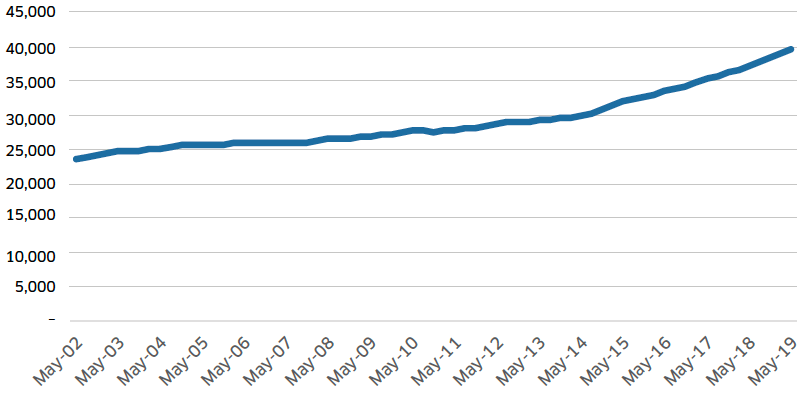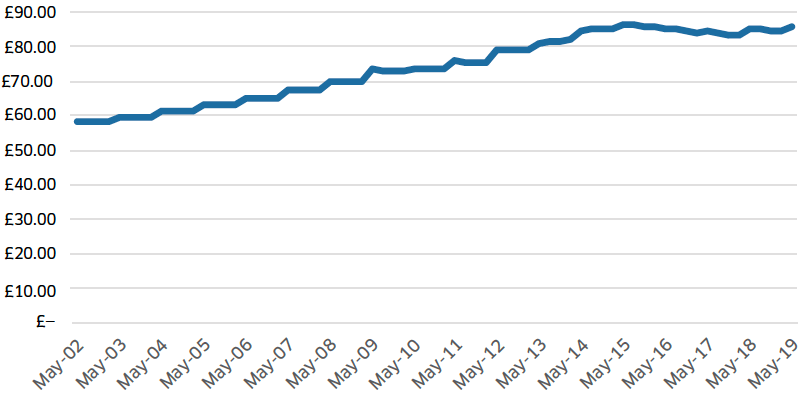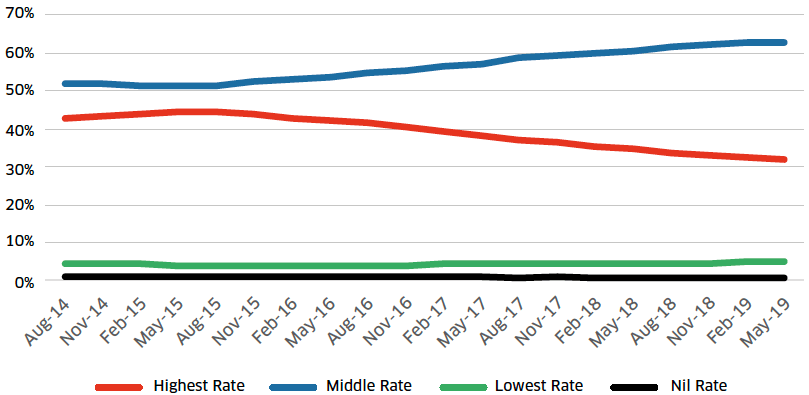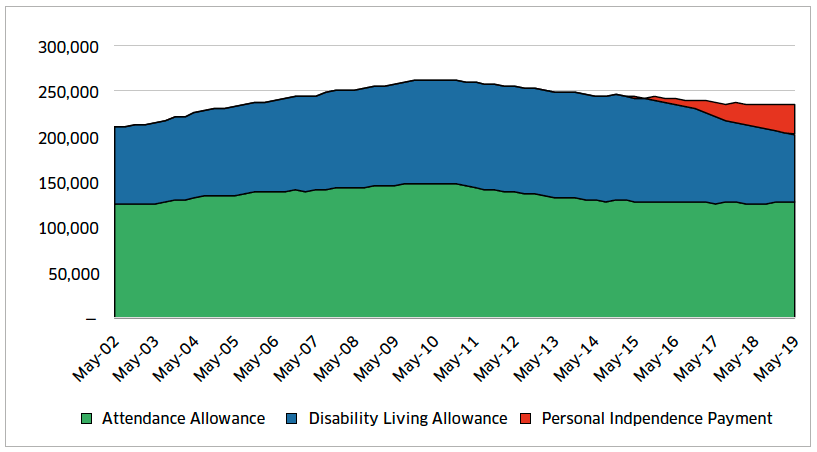Welfare reform: impact report on benefits for disabled people
This report examines new evidence on the effect of UK Government welfare reforms on benefits for disabled people in Scotland.
This document is part of a collection
4. Disability benefits for children and older people
4.1 Disability Living Allowance for children
While PIP has been replacing DLA for working-age people, the guardians of disabled children can continue to make new claims to DLA and DLA claims for disabled children will remain valid until they reach the age of 16. While the replacement of DLA for working-age and pension-age people has greatly reduced the DLA caseload for those groups, the caseload for child DLA has continued on the same upward trajectory. In fact, in the six years to February 2019 (i.e. since the rollout of PIP) the caseload of child DLA has increased by 36%, as shown in Figure 11.
Figure 11 – Child DLA caseload over time, Scotland

Source: DWP Stat-Xplore
On the other hand, the average award of child DLA has seen a much slower increase over the same time period. Because disability benefits were exempt from the benefit freeze, the rate for each element of entitlement has kept pace with inflation e.g. the monetary value of the middle care component increased from £53 per week in 2013/14 to £58.70 per week in 2018/19. This represents a cumulative increase of over 10% in nominal terms.
Despite this, when we look at changes in the average entitlement to child DLA over time, the peak occurred in August 2015 when the average weekly award was worth £86.19. This is shown in Figure 12, which presents the long-term change in average child DLA awards in Scotland.
Figure 12 – Child DLA average weekly awards over time, Scotland

Source: DWP Stat-Xplore
The most recent May 2019 data show that the average award is now worth slightly less than it was four years earlier. DLA awards are made up of care and mobility components, with components for people with more severe disabilities providing a higher level of award. For average awards to decrease despite components being uprated by CPI each year requires that, on average, children are being awarded with less valuable benefit components at DLA assessments than they were before.
Our analysis indicates that much of this decrease in awards relates to changes in the composition of the benefit caseload, and how children with certain conditions have become less likely to receive the highest rate of the care component in recent years.
In August 2014, i.e. one year before the peak in the average child DLA award, the majority (around 60%) of the child DLA caseload had one of three main disabling conditions: - learning difficulties (40% of the caseload), behavioural disorders (10%) and hyperkinetic syndrome (10%). Five years later, the most recent May 2019 data show that around 70% of the caseload qualified for child DLA through one of these main disabling conditions.
Over the same time period, children with these conditions have increasingly been awarded a lower care component than they did before, as shown in Figure 13.
Figure 13 – Breakdown of Child DLA caseload with main disabling condition categorised as “Learning Difficulties”, “Behavioural Disorder” or “Hyperkinetic Syndrome” by care component awarded, Scotland

Source: DWP Stat-Xplore
Since mid-2015, children with these conditions have become significantly less likely to receive the highest care component, and more likely to be awarded the middle rate. This has, in turn, affected the average child DLA award over recent years, as more children with these conditions (representing most of the child DLA caseload) are awarded the £58.70 per week middle rate, rather than the £87.65 highest rate.
4.2 Disability benefits for pensioners
Disability benefits for people of state pension age are somewhat more complex than for children or working-age adults. Disabled pensioners can be on one of three benefits, depending on their circumstances:
- DLA: If already on DLA and older than state pension age in 2013 when PIP rolled out, people can continue their DLA claim.
- PIP: If younger than state pension age when PIP rolled out, people could have made a new PIP claim before reaching pension age. Alternatively, if they were already on DLA then the DWP will eventually migrate them onto PIP, even if they are now older than pension age.
- AA: If people make a new disability benefit claim when they are older than pension age, they will be referred to claim Attendance Allowance (AA).
This combination of rules means pension-age disability benefit claimants are spread across three different benefits, as shown in Figure 14.
Figure 14 – Caseload of pension-age disability benefit claimants over time, Scotland

Source: DWP Stat-Xplore
As shown above, AA has consistently been the most common disability benefit amongst older people. However, an increasing number of pension-age people are claiming PIP, as people who were younger than pension-age in 2013 move over from DLA. A further influx also occurs as people who claimed PIP while working-age reach pension-age.
Contact
Email: Jamie.Hume@gov.scot
There is a problem
Thanks for your feedback